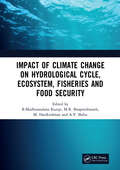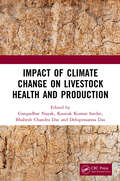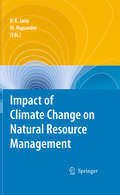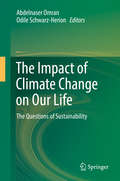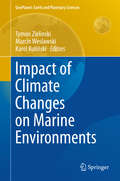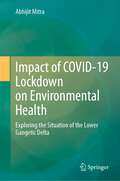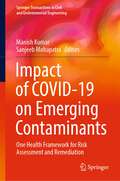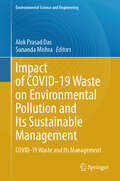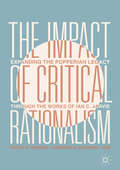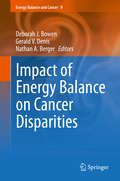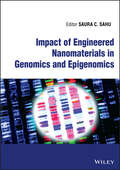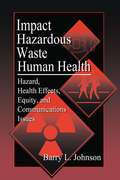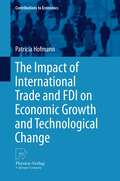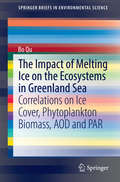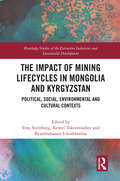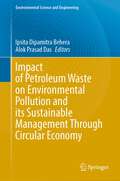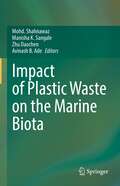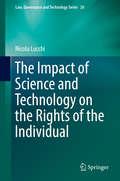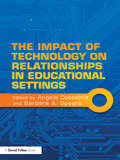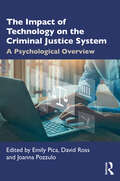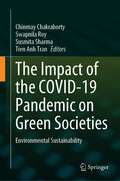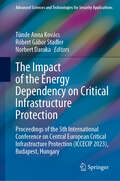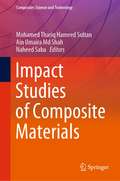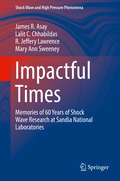- Table View
- List View
Impact of Climate Change on Hydrological Cycle, Ecosystem, Fisheries and Food Security
by B. Madhusoodana KurupClimate change has emerged as the most pressing global challenge of the 21st century and it has a dramatic effect on natural ecosystems and environment. Intelligent mitigation strategies to minimise climate change impacts can result in advanced, novel technologies; healthier aquatic ecosystems and higher food security and well-being for humans. The book includes 45 Chapters by expert authors, covering (i) Hydrometeorology and hydrology, (ii) Natural hazards and disaster risk management, (iii) Aquaculture, (iv) Changing biodiversity scenarios, (v) Capture fisheries, (vi) Food and nutritional insecurity, (vii) Climate change and socio-economic scenarios, and allied areas. It is hoped that this volume will further our understanding and research achievements in the field of climate change and its consequences and facilitate the synthesis of information on how climate-related changes will influence oceans, marine and inland ecosystems, hydrological cycles, fisheries and aquaculture and coastal communities and will be immensely useful to planners, scientists, conservationists, environmentalists, academicians, students and all those who are directly or indirectly involved in the study of impact of climate change and mitigation measures Note: T& F does not sell or distribute the Hardback in India, Pakistan, Nepal, Bhutan, Bangladesh and Sri Lanka.
Impact of Climate Change on Livestock Health and Production
by G D Nayak K K Sardar B C Das D P DasThis volume of 30 chapters contributed by reputed authors covers: Diversification of livestock and crops. Integration of livestock systems with forestry and crop production. Drought and heat wave tolerant varieties. Strategies for reduction of Green House Gases emission from ruminants. Application of GIS and remote sensing technologies. Breeds with inherent genetic capabilities to adapt to climate change. This book also takes into account the climate change adaptation, mitigation practices, and policy frameworks for promotion of sustainable livestock and poultry production. This book is co-published with NIPA. Taylor and Francis does not sell or distribute its print and electronic editions in India, Pakistan, Nepal, Bhutan, Bangladesh and Sri Lanka.
Impact of Climate Change on Natural Resource Management
by Bipal Kr. Jana Mrinmoy MajumderAs climate change takes hold, there is an ever-growing need to develop and apply strategies that optimize the use of natural resources, both on land and in water. This book covers a huge range of strategies that can be applied to various sectors, from forests to flood control. Its aim, as with resource management itself, is to combine economics, policy and science to help rehabilitate and preserve our natural resources. Beginning with papers on carbon sequestration, including the practice of artificial desertification, the topics move on to cover the use of distributed modeling and neural networks in estimating water availability and distribution. Further chapters look at uncertainty analysis applied to the spatial variation of hydrologic resources, and finally the book covers attempts at estimating meteorological parameters in the context of hydrological variables such as evapo-transpiration from stream flow. Within the next decade, the effects of climate change will be severe, and felt by ordinary human beings. This book proposes a raft of measures that can mitigate, if not reverse, the impact of global warming on the resources we have all come to depend on.
The Impact of Climate Change on Our Life: The Questions Of Sustainability
by Abdelnaser Omran Odile Schwarz-HerionThis book introduces the highly topical issue from many different angles, sensitizing readers to the various challenges to human life posed by climate change, identifying possible intentional and inadvertent anthropogenic factors and consequences, and seeking socially and environmentally viable solutions. The book begins by examining the impact of the climate change discussion on science, politics, economy and culture – from its historical origin in the first Club of Rome Report and its inclusion in the UN's SDGs to the Paris Agreement and beyond. Comprising 12 chapters, it analyses the factors which caused the catastrophic 2014 Kelantan flood in Malaysia, focusing on the Kuala Krai district and discusses mud architecture in Wadi Hadramout, Yemen and mitigating the expected effects of climate change on this unique architecture and cultural heritage. It also examines the economic costs of climate change on health and the increased burden on individual expenditures and national health systems. The role of climate change in the water-energy nexus and efforts to increase efficiency in energy and water end-use to increase Queensland’s agricultural sector’s resilience in Australia is addressed, as is water security and climate change issues in developing countries and the potential of partnership procurement strategies for managing sustainable urban water supply in Nigerian cities. It also includes a chapter offering a new approach to waste management, exploring to what extent waste can complicate our daily actions and influence environmental decay, and recommending that renewable materials be sorted and separated from other types of materials to avoid cross-contamination, to increase the value of the materials, and to ease the process of manufacturing. Subsequent chapters identify factors sustaining the municipal solid waste management and practices in Ajdabiya city in Libya, and look at accounting disclosure remedies by exploring areas in which sustainability reporting could expand beyond corporate environmental reporting to additional disclosures, curbing recklessness in pursuing merely economic goals. The book shows – from the perspective of agriculture – how human activities can increase the negative impacts of climate change on lifestyle in Malaysia, suggesting alternative lifestyles and encouraging international cooperative efforts. The last chapters evaluate the impacts of various environmental factors on the local tourism sector in Pakistan, and discuss strategies to tackle climate change, focusing on the opportunities and risks of climate engineering. Since these risks encompass inadvertent negative effects and targeted abuse for covert weather warfare and terrorism that violate the UN’s ENMOD convention, the author recommends viable alternatives to deal with climate change.
Impact of Climate Changes on Marine Environments
by Tymon Zielinski Marcin Weslawski Karol KulińskiThis book contributes to the current discussion on global environmental changes by discussing modifications in marine ecosystems related to global climate changes. In marine ecosystems, rising atmospheric CO2 and climate changes are associated with shifts in temperature, circulation, stratification, nutrient input, oxygen concentration and ocean acidification, which have significant biological effects on a regional and global scale. Knowing how these changes affect the distribution and abundance of plankton in the ocean currents is crucial to our understanding of how climate change impacts the marine environment. Ocean temperatures, weather and climatic changes greatly influence the amount and location of nutrients in the water column. If temperatures and currents change, the plankton production cycle may not coincide with the reproduction cycle of fish. The above changes are closely related to the changes in radiative forcing, which initiate feedback mechanisms like changes in surface temperature, circulation, and atmospheric chemistry.
Impact of COVID-19 Lockdown on Environmental Health: Exploring the Situation of the Lower Gangetic Delta
by Abhijit MitraThis book examines the impacts that the COVID-19 lockdown has had on environmental and ecological health, with a focus on coastal ecosystems in the Lower Gangetic Delta. The book begins with an overview of COVID-19's spread and impact before and after the lockdown in the focus region, then addresses the specific impacts that the lockdown period had and continues to have on air quality, marine and estuarine water quality, coastal biodiversity, and the livelihoods of the region's inhabitants, especially those who live below the poverty line. The decrease in human activity combined with the complete closure of various sectors, including air travel, oil and gas drilling, and construction, has had a pronounced effect on biodiversity and overall environmental health that is yet to be fully realized. The book sheds light on these changes and assesses how biodiversity, ambient air quality, and ecosystem functioning will progress as COVID-19 remains a threat and the lockdown persists. The study will be of interest to researchers, government officials and professionals dealing with disaster management, environmental science, biological science, and health.
Impact of COVID-19 on Emerging Contaminants: One Health Framework for Risk Assessment and Remediation (Springer Transactions in Civil and Environmental Engineering)
by Manish Kumar Sanjeeb MohapatraThe book brings out several unique perspectives of impacts of COVID-19 on the environment with special emphasis on the risk and remediation of emerging contaminants. Idea is to work out under the one health framework and comprehend not only scientific and technical aspects but also environmental, legal and policy aspects for water resources management. The obvious stress is given to the occurrence, fate and transport of geogenic, microbial and anthropogenic contaminants of emerging concern under the preview of the fact that antibiotic and antiviral use has been unprecedented during the global pandemic of COVID-19. At the same time, this edited volume touches upon the broader framework of integrated water resource management, as well as mitigation and removal strategies to put forward a holistic picture to the readers and policymakers. These contents are divided into three sections: a) monitoring, occurrence, distribution and fate of emerging contaminants; b) source and effects of these contaminants on the total environment; and c) treatment strategies, natural attenuation and mitigation.
Impact of COVID-19 Waste on Environmental Pollution and Its Sustainable Management: COVID-19 Waste and Its Management (Environmental Science and Engineering)
by Alok Prasad Das Sunanda MishraThis book focuses on challenges that have arisen because of trash discharges and their potential causes and provides long-term sustainable solutions. Globally, the COVID-19 pandemic has caused immense devastation, leading to numerous fatalities as well as substantial economic losses and health issues. With the rise in COVID-19 cases, the amount of biomedical waste has multiplied, exposing more people to the epidemic. For developing countries, waste management is already a problem, and the waste generated during this pandemic situation has made things worse. If improper waste management techniques are not changed, the world will face a new crisis that could be referred to as a "garbage crisis." The increased quantity of COVID-19-associated waste (CAW) and their presence in the environment make them more vulnerable, potentially increasing the danger of food chain contamination. A few countries have already started putting emergency plans in place to address the “waste crisis.” Given the paucity of information on the mutational features and potential hosts of this newly discovered COVID-19, there is a pressing need for an effective plan to protect India's ecosystem against further contamination. To handle the current crisis and prevent the anticipated waste disaster, it is imperative to construct a more effective, automated, computerized, and well-modified waste management system during the COVID-19 period.
The Impact of Critical Rationalism: Expanding the Popperian Legacy through the Works of Ian C. Jarvie
by Raphael Sassower Nathaniel LaorAs a student and disciple of Karl Popper and longtime managing editor of Philosophy of the Social Sciences, Ian C. Jarvie extended the notion of Critical Rationalism to be useful in anthropology, aesthetics, film studies, and various social sciences. In this Festschrift, contributors from a range of interests and disciplines engage with the Popperian legacy and Jarvie’s scholarly and editorial work in Critical Rationalism to contextualize it in the broader, contemporary intellectual landscape. These original essays not only honor Jarvie’s legacy, but expand it to cross the philosophical divide between analytic and continental schools of thought. In so doing, the authors bring the state-of-the-art achievements of Critical Rationalism to the forefront of current academic debates.
The Impact of Discovering Life Beyond Earth
by Steven J. DickThe search for life in the Universe, once the domain of science fiction, is now a robust research program with a well-defined roadmap, from studying the extremes of life on Earth to exploring the possible niches for life in the Solar System and discovering thousands of planets far beyond it. In addition to constituting a major scientific endeavor, astrobiology is one of the most popular topics in astronomy, and is of growing interest to a broad community of thinkers from across the academic spectrum. In this volume, distinguished philosophers, theologians, anthropologists, historians and scientists discuss the big questions about how the discovery of extraterrestrial life, whether intelligent or microbial, would impact society. Their remarkable and often surprising findings challenge our foundational concepts of what the discovery of alien life may hold for humankind. Written in easily accessible language, this thought-provoking collection engages a wide audience of readers from all backgrounds.
Impact of Energy Balance on Cancer Disparities
by Deborah J. Bowen Gerald V. Denis Nathan A. BergerThis volume reviews disparities in cancer genetics, etiology, treatment and survivorship that are associated with differences in energy balance and how those differences and disparities may be affected by geography, socioeconomic status, ethnicity, biology, behavior and others. State-of-the-art strategies are outlined to alter these problems at the individual, community and policy levels. The book provides a comprehensive assessment of the multiple contributions of disparities in energy balance and how they affect cancer. this volume should constitute a valuable resource to disparity focused investigators at all levels and serves an important guide to professionals that deal with these issues, especially those who determine and implement policy.
Impact of Engineered Nanomaterials in Genomics and Epigenomics
by Saura C. SahuImpact of Engineered Nanomaterials in Genomics and Epigenomics Overview of current research and technologies in nanomaterial science as applied to omics science at the single cell level Impact of Engineered Nanomaterials in Genomics and Epigenomics is a comprehensive and authoritative compilation of the genetic processes and instructions that specifically direct individual genes to turn on or off, focusing on the developing technologies of engineering nanomaterials and their role in cell engineering which have become important research tools for pharmaceutical, biological, medical, and toxicological studies. Combining state-of-the art information on the impact of engineered nanomaterials in genomics and epigenomics, from a range of internationally recognized investigators from around the world, this edited volume offers unique insights into the current trends and future directions of research in this scientific field. Impact of Engineered Nanomaterials in Genomics and Epigenomics includes detailed information on sample topics such as: Impact of engineered nanomaterials in genomics and epigenomics, including adverse impact on glucose energy metabolism Toxicogenomics, toxicoepigenomics, genotoxicity and epigenotoxicity, and mechanisms of toxicogenomics and toxicoepigenomics Adverse effects of engineered nanomaterials on human environment and metabolomics pathways leading to ecological toxicity Meta-analysis methods to identify genomic toxicity mechanisms of engineered nanomaterials and biological effects of engineered nanomaterial exposure Artificial intelligence and machine learning of single-cell transcriptomics of engineered nanoparticles and trends in plant nano-interaction to mitigate abiotic stresses This comprehensive work is a valuable and excellent source of authoritative and up-to-date information for advanced students and researchers, toxicologists, the drug industry, risk assessors and regulators in academia, industry, and government, as well as for clinical scientists working in hospital and clinical environments.
Impact of Hazardous Waste on Human Health: Hazard, Health Effects, Equity, And Communications Issues
by Barry L. JohnsonThe author of Impact of Hazardous Waste on Human Health is a public health official with the unique perspective that only insider status can provide. His book is intended for policy makers, environmentalists, toxicologists, public health officials, academic personnel, and health care providers. The author addresses six themes: hazardous waste issues must be more vigorously examined, site remediation is critical, risk management must extend beyond waste site clean up, disease prevention must be a priority, interagency partnership is mandatory, and the best technology must be applied. Johnson also considers the pros and cons of the Comprehensive Environmental Response, Compensation, and Liability Act (CERCLA) also known as the "Superfund." His years of experience with this law, and countless other issues related to hazardous waste, make Impact of Hazardous Waste on Human Health an important and positive contribution.
The Impact of International Trade and FDI on Economic Growth and Technological Change
by Patricia HofmannEconomic globalisation and technological change are the two issues that concerned people in the past, concern them today and will concern them in the future - all over the world, poor or rich. Traditionally, questions about allocative effects are asked: What are the labour market implications? Who loses? Who wins? What is the net aggregate welfare effect after an adjustment period? However, two points are rarely taken into consideration: How do globalisation and technological change interact and what are the potential long-run implications for economic growth? This book addresses the interplay of these megatrends. It asks how economic globalisation may affect innovation and technology of individual firms and eventually the growth prospects of countries. Thereby it shows that protectionism not only harms static efficiency but might as well lead to dynamic losses. The book provides a systematic overview of the theoretical underpinnings of the openness-growth nexus and summarises the conceptual problems and important findings of the empirical analyses so far. The theoretical insights are supported by two empirical studies, the first dealing with the innovative behaviour and the "within-multinational" technology transfer of Spanish firms that were acquired by foreign companies and the second analysing productivity growth rate implications from exporting for German manufacturing firms.
The Impact of Melting Ice on the Ecosystems in Greenland Sea
by Bo QuArctic marine ecosystems are largely impacted by changes associated with global warming. The sea ice in Greenland Sea plays an important role in regional and global climate system. The book investigate the relationships between phytoplankton biomass, measured using remotely sensed chlorophyll-a (CHL), aerosol optical depth (AOD) and sea-ice cover (ICE) in the Greenland Sea (20°W-10°E, 65-85°N) over the period 2003-2012. First hand Satellite data was used to do correlation analysis. Enhanced statistics methods, such as lag regression method and cointegration analysis method are used for correlation and regression analysis between 2 variables (up to 3 variables). ARMA model was used to prediction time series in the future 3 years. The book not only gives outline of ecosystem in Greenland Sea, how the ice impact to the local ecosystems, but also provides valuable statistical methods on analysis correlations and predicting the future ecosystems.
The Impact of Mining Lifecycles in Mongolia and Kyrgyzstan: Political, Social, Environmental and Cultural Contexts (Routledge Studies of the Extractive Industries and Sustainable Development)
by Troy SternbergThis volume investigates how mining affects societies and communities in Mongolia and Kyrgyzstan. As ex-Soviet states, Mongolia and Kyrgyzstan share history, culture and transitions to democracy. Most importantly, both are mineral-rich countries on China’s frontier and epi-centres of resource extraction. This volume examines challenges communities in these countries encounter on the long journey through resource exploration, extraction and mine closure. The book is organised into three related sections which travel from mine licensing and instigation to early anticipation of benefit through the realisation of social and environmental impacts to finite issues such as jobs, monitoring, dispute resolution and reclamation. Most originally, each chapter will include a final section entitled ‘Notes from the Field’ that presents the voice of in-country researchers and stakeholders. These sections will provide local contextual knowledge on the chapter’s theme by practitioners from Mongolia and Central Asia. The volume thereby offers a distinctively grounded perspective on the tensions and benefits of mining in this dynamic region. Using Mongolia and Kyrgyzstan as case studies, the volume reflects on the evolving challenges communities and societies encounter with resource extraction worldwide. The book will be of great interest to students and scholars of mining and natural resource extraction, corporate social responsibility and sustainable development.
Impact of Petroleum Waste on Environmental Pollution and its Sustainable Management Through Circular Economy (Environmental Science and Engineering)
by Ipsita Dipamitra Behera Alok Prasad DasThe purpose of this book is to discuss the challenges that have arisen due to petroleum hydrocarbon wastes, their harmful effects to the ecosystem, and limitations as well as improvement of current biological techniques’ use for management of petroleum hydrocarbon wastes. This book focuses on the role of advanced green engineering technologies for sustainable petroleum waste management in building an economic supportable society as a basic need of developing countries. The rapid economic growth achieved in last decade has been paralleled by an increase in global energy consumption resulting generation of massive amount of industrial wastes. Petroleum wastes release through spillages and leakage from underground tanks, steamers, unplugging of oil wells, and abandoned oil refinery sites that cause extensive contamination of surface soils, groundwater, seas, and ocean resulting in ecosystem damage. Apart from these, petroleum industries release a significant amount of hydrocarbon wastes during processing of crude oil. Improper waste management technique of these petroleum wastes may cause a serious effect toward the living beings. The presence of these hazardous wastes in the environment will make vulnerable conditions to the aquatic as well as terrestrial life. Till date, a number of conventional techniques have been implemented to treat these petroleum hazardous wastes, but biological treatment is more efficient among all on basics of economic and environmental point of view. Bioaugmentation, biostimulation, and combinatorial bioaugmentation and biostimulation waste management strategies are implemented to treat these wastes. In addition to these techniques, biocomposting/biopile, land treatment, and bio-slurry methods have also been employed to reduce the endanger effects of petroleum wastes. Integrating waste management through environmental sustainability and economic development is one of the prime milestones in the circular economy. There is an exigent necessity for developing countries to go ahead toward a circular economy for achieving its Sustainable Development Goals.
Impact of Plastic Waste on the Marine Biota
by Mohd. Shahnawaz Manisha K. Sangale Avinash B. Ade Zhu DaochenThis contributed volume focuses on the effects of macro, meso, micro, and nanoplastic waste on marine biota. It discusses the threats posed by plastic waste on the flora and fauna in the marine environment. This book will help in understanding different aspects of plastic waste generation, its transportation with different natural and anthropogenic ways, its accumulation at the seacoast, and its impact on marine biota. The book also suggests strategies for saving marine life from threats posed by plastic waste and presents methods to reduce its generation using different strategies. This book is of interest to teachers, researchers, climate change scientists, capacity builders, and policymakers. It also serves as additional reading material for undergraduate and postgraduate students of Ecology, Botany, and Environmental Sciences.
The Impact of Science and Technology on the Rights of the Individual
by Nicola LucchiThevolume is devoted to the relevant problems in the legal sphere, created andgenerated by recent advances in science and technology. In particular, itinvestigates a series of cutting-edge contemporary and controversialcase-studies wherescientific and technological issues intersect withindividual legal rights. The book addresses challenging topics at theintersection of communication technologies and biotech innovations such asfreedom of expression, right to health, knowledge production, Internet contentregulation, accessibility and freedom of scientific research.
The Impact of Technology on Relationships in Educational Settings
by Barbara A. Spears Angela CostabileAs the linguistic, cognitive and social elements of our lives are transformed by new and emerging technologies, educational settings are also challenged to respond to the issues that have arisen as a consequence. This book focuses on that challenge: using psychological theory as a lens to highlight the positive uses of new technologies in relationships and educational settings, and to advocate technological learning opportunities and social support where the misuse and abuse of ICT occurs. The Impact of Technology on Relationships in Educational Settings sets out to explore the role of ICTs in relationship forming, social networking and social relationships within our schools and has grown out of the European Cooperation in Science and Technology (COST); Action on cyberbullying, involving 28 participating countries, and two non-COST countries, of which Australia is one. This cutting edge international text offers cross-cultural, psychological perspectives on the positive uses of new and emerging technologies to improve social relationships and examples of best practice to prevent virtual bullying. This comes at a time when much of the focus in current writings has been on the more negative aspects which have emerged as new technologies evolved: cyberbullying, cyber-aggression and cybersafety concerns. This text is ideally suited to researchers and practiitioners in the fields of Educational and developmental psychology, as well as those specialising in educational technology and the sociology of education.
The Impact of Technology on the Criminal Justice System: A Psychological Overview
by Emily Pica David Ross Joanna PozzuloThis comprehensive volume explores the impact of emerging technologies designed to fight crime and terrorism. It first reviews the latest advances in detecting deception, interrogation, and crime scene investigation, before then transitioning to the role of technology in collecting and evaluating evidence from lay witnesses, police body cameras, and super-recognizers. Finally it explores the role of technology in the courtroom with a particular focus social media, citizen crime sleuths, virtual court, and child witnesses. It shines light on emerging issues, such as whether new norms have been created in the emergence of new technologies and how human behaviour has shifted in response. Based on a global range of contributions, this volume provides an overview of the technological explosion in the field of law enforcement and discusses its successes and failures in fighting crime. It is valuable reading for advanced students in forensic or legal psychology and for practitioners, researchers, and scholars in law, criminal justice, and criminology.
The Impact of the COVID-19 Pandemic on Green Societies: Environmental Sustainability
by Chinmay Chakraborty Swapnila Roy Susmita Sharma Tien Anh TranThis book covers the sustainability issues of a green environment towards economics and society in terms of alteration in industrial pollution levels, effect of reduced carbon emissions, changes in water bodies characteristics with respect to heavy metal contamination, monitoring of associated impact with respect to ecology and biodiversity, impact of reduced noise levels and air quality influences on human health, handling and management of biomedical waste. According to WHO, 80% of people living in urban areas are exposed to air exceeding safe limits. The advent of "sustainability‟ in development science has led planners to apply evolving notions of "sustainability‟ to the contemporary debate over how cities and regions should be revitalized, redeveloped, and reformed. Market allocation of resources, sustained levels of growth and consumption, an assumption that natural resources are unlimited and a belief that economic growth will „trickle down‟ to the poor have been its hallmarks. The recent advance technology helps to promote green and clean modern societies continuously. The Internet of things will be playing an important role in the upcoming years in environment protection and sustainable development. There is a focus on paradigm shift in the sustainable development for the green environment during the period of isolation of COVID-19. This is the moment for the mobilization against the climate crisis. The sudden fall in pollutants and subsequent blue skies signifies a dramatic shift for India and also other affected countries during this period. Fighting climate change requires a collaborative approach between all spheres of society unlike the former. It must heavily redirect resources towards local, sustainable activities, including education, health, sustainable agriculture and circular management of resources. The impact of COVID-19 pandemic which has resulted in the dramatic change in the different aspects of the environment. The global lockdown has led to a rejuvenation of nature, ecosystems, biodiversity. Even urban environments are discovering a degree of peace and serenity, which led to decrease in greenhouse gas emission.
The Impact of the Energy Dependency on Critical Infrastructure Protection: Proceedings of the 5th International Conference on Central European Critical Infrastructure Protection (ICCECIP 2023), Budapest, Hungary (Advanced Sciences and Technologies for Security Applications)
by Tünde Anna Kovács Róbert Gábor Stadler Norbert DarukaThis book presents cutting-edge research on the impact of energy dependence and strategies to mitigate it. As a crucial component of critical infrastructure, energy security is a top priority for nations worldwide. The protection of this infrastructure, along with the latest research tools and methodologies, is of significant interest to both policymakers and industry leaders. The book delves into two primary areas of research: cybersecurity and physical security, summarizing the latest findings in these critical fields. The papers in this volume offer valuable insights for both academic and industrial audiences, addressing the pressing challenges of energy security. Energy is integral to every aspect of our daily lives. Our comfort, as well as our safety, hinges on the uninterrupted supply of energy. Recent global events, particularly the Russian-Ukrainian war, have underscored the vulnerability of nations lacking sufficient energy resources. Europe's energy supply has been severely disrupted by sanctions, highlighting the need for energy resilience. However, this crisis has also accelerated the adoption of renewable energy sources, marking a pivotal shift towards sustainable energy solutions.
Impact Studies of Composite Materials (Composites Science and Technology)
by Mohamed Thariq Hameed Sultan Ain Umaira Md Shah Naheed SabaThis book discusses the impact of different range of velocities (low, high, ballistic and hyper-velocity impact) on composites. Presented through experimental and numerical analysis, the book goes beyond impact event analysis and also covers the after-impact phenomena, including flexural and compression and damage analysis through destructive and non-destructive evaluations. The analyses presented from either experimental or numerical simulations are composed of micro and macrographs images, illustrations, tables and figures with inclusive discussions and supportive evidences from recent studies on composites. This book also highlights the potential applications of composites through the lens of their impact properties, in different industries such as automotive and defence applications. Generally, this book benefits wider range of readers including the industrial practitioners, researchers, lecturer and students, who are working in the fields related to impact and damage analysis, including the structural health monitoring of composites, either experimentally or numerically.
Impactful Times
by James R. Asay Lalit C. Chhabildas R. Jeffery Lawrence Mary Ann SweeneyThis book presents a history of shock compression science, including development of experimental, material modeling, and hydrodynamics code technologies over the past six decades at Sandia National Laboratories. The book is organized into a discussion of major accomplishments by decade with over 900 references, followed by a unique collection of 45 personal recollections detailing the trials, tribulations, and successes of building a world-class organization in the field. It explains some of the challenges researchers faced and the gratification they experienced when a discovery was made. Several visionary researchers made pioneering advances that integrated these three technologies into a cohesive capability to solve complex scientific and engineering problems. What approaches worked, which ones did not, and the applications of the research are described. Notable applications include the turret explosion aboard the USS Iowa and the Shoemaker-Levy comet impact on Jupiter. The personal anecdotes and recollections make for a fascinating account of building a world-renowned capability from meager beginnings. This book will be inspiring to the expert, the non expert, and the early-career scientist. Undergraduate and graduate students in science and engineering who are contemplating different fields of study should find it especially compelling.
